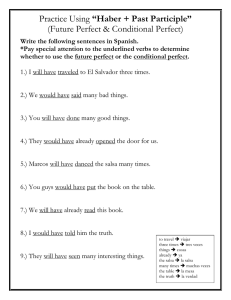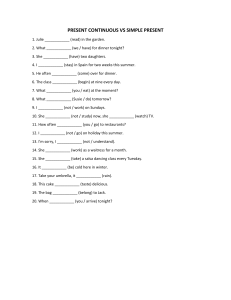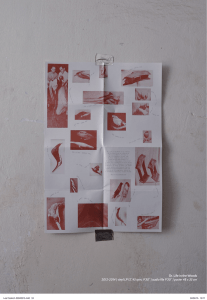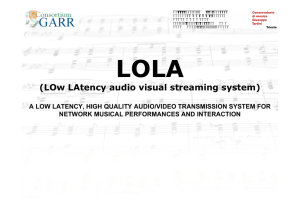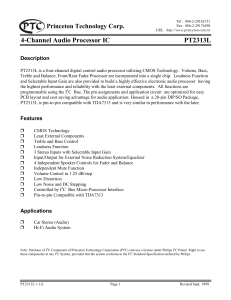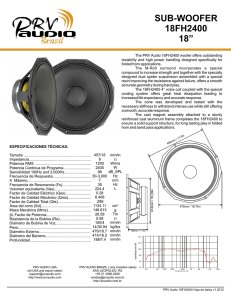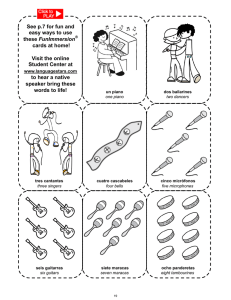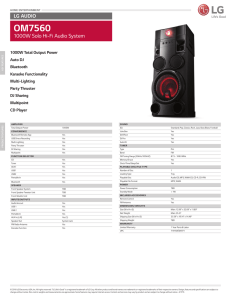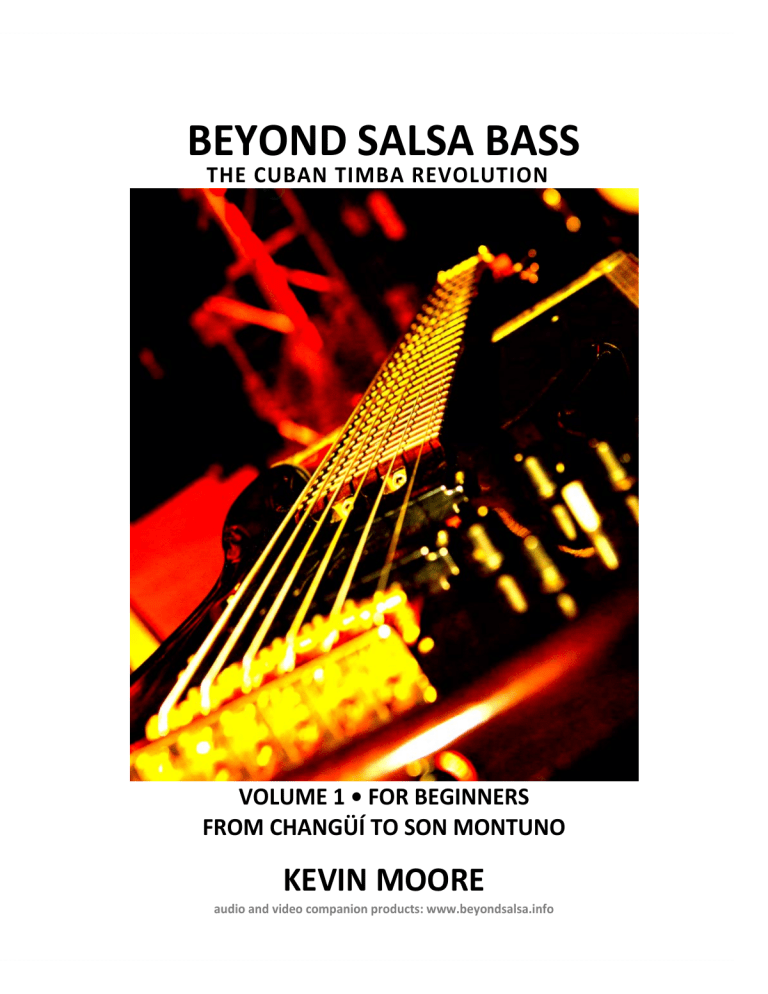
BEYOND SALSA BASS THE CUBAN TIMBA REVOLUTION VOLUME 1 • FOR BEGINNERS FROM CHANGÜÍ TO SON MONTUNO KEVIN MOORE audio and video companion products: www.beyondsalsa.info cover photo: Jiovanni Cofiño’s bass – 2013 – photo by Tom Ehrlich REVISION 1.0 ©2013 BY KEVIN MOORE SANTA CRUZ, CA ALL RIGHTS RESERVED No part of this publication may be reproduced in whole or in part, or stored in a retrieval system, or transmitted in any form or by any means, electronic, mechanical, photocopy, recording or otherwise, without written permission of the author. ISBN‐10: 1482729369 ISBN‐13/EAN‐13: 978‐148279368 H www.beyondsalsa.info www.timba.com/users/7 [email protected] H H H H H 2 Table of Contents Introduction to the Beyond Salsa Bass Series...................................................................................... 11 Corresponding Bass Tumbaos for Beyond Salsa Piano .................................................................... 12 Introduction to Volume 1..................................................................................................................... 13 What is a bass tumbao? ................................................................................................................... 13 Sidebar: Tumbao Length .................................................................................................................... 1 Difficulty Levels ................................................................................................................................ 14 Fingering........................................................................................................................................... 14 About Clave ...................................................................................................................................... 14 3‐2 son clave • Audio Tracks 0‐01a & 0‐01b ................................................................................ 15 2‐3 son clave • Audio Tracks 0‐02a & 0‐02b ................................................................................ 15 Notation and Tablature in this Book ................................................................................................ 16 Audio and Video – How Beyond Salsa is Organized and Marketed................................................. 17 Books........................................................................................................................................ 17 Audio ........................................................................................................................................ 17 Video ........................................................................................................................................ 17 Chapter 1: The 16 Generic Clave‐Neutral Bass Tumbao Rhythms....................................................... 18 To Name or Not to Name................................................................................................................. 18 Chord Progressions .......................................................................................................................... 19 Generic Tumbao 1‐1: bolero • Audio Tracks 1‐01a & 1‐01b........................................................ 19 Generic Tumbao 1‐2: tresillo • Audio Tracks 1‐02a & 1‐02b ....................................................... 20 Generic Tumbao 1‐3: habanera • Audio Tracks 1‐03a & 1‐03b................................................... 21 Generic Tumbao 1‐4: guaracha • Audio Tracks 1‐04a & 1‐04b ................................................... 22 The Anticipated Bass (AB) ................................................................................................................ 23 Generic Tumbao 1‐5: bolero (AB) • Audio Tracks 1‐05a & 1‐05b................................................ 26 3 Generic Tumbao 1‐6: tresillo (AB) (or bombo‐ponche) • Audio Tracks 1‐06a & 1‐06b ............... 27 Generic Tumbao 1‐7: habanera (AB) • Audio Tracks 1‐07a & 1‐07b ........................................... 28 Generic Tumbao 1‐8: guaracha (AB) • Audio Tracks 1‐08a and 1‐08b ........................................ 28 The Doubled Ponche (DP) ................................................................................................................ 29 Sidebar: Rhythmic Terminology......................................................................................................... 1 Generic Tumbao 1‐9: bolero (DP) • Audio Tracks 1‐09a & 1‐09b............................................... 30 Generic Tumbao 1‐10: tresillo (DP) • Audio Tracks 1‐10a & 1‐10b ............................................ 31 Generic Tumbao 1‐11: habanera (DP) • Audio Tracks 1‐11a & 1‐11b ........................................ 31 Generic Tumbao 1‐12: guaracha (DP) • Audio Tracks 1‐12a & 1‐12b......................................... 32 Generic Tumbao 1‐13: bolero (AB‐DP) • Audio Tracks 1‐13a & 1‐13b ........................................ 33 Generic Tumbao 1‐14: tresillo (AB‐DP) • Audio Tracks 1‐14a & 1‐14b........................................ 33 Generic Tumbao 1‐15: habanera (AB‐DP) • Audio Tracks 1‐15a & 1‐15b ................................... 34 Generic Tumbao 1‐16: guaracha (AB‐DP) • Audio Tracks 1‐16a & 1‐16b.................................... 35 Looking Ahead.................................................................................................................................. 36 Chapter 2: The History of the Bass Tumbao ........................................................................................ 37 The European Inheritance................................................................................................................ 38 Tumbao 2‐1: Ostinato for Pachelbel’s Canon • Audio Track 2‐01 ............................................... 39 The African Inheritance.................................................................................................................... 40 Tumbao 2‐2: Bass Adaptation of Guaguancó • Audio Tracks 2‐2a & 2‐2b .................................. 41 The Missing Link: Changüí................................................................................................................ 43 Tumbao 2‐3: Bass Adaptation of Changüí Marímbula • Audio Tracks 2‐3a & 2‐3b..................... 44 Understanding the Changüí Time Feel......................................................................................... 44 The Changüí Guajeos of Beyond Salsa Piano, Vol. 1 .................................................................... 46 Chapter 3: Danzón................................................................................................................................ 47 4 Why is danzón so important? .......................................................................................................... 47 Getting Into Danzón ......................................................................................................................... 47 Further Listening Recommendations for Danzón ........................................................................ 48 Understanding Danzón Form ........................................................................................................... 49 Baqueteo (güiro) • Audio Tracks 3‐1a & 3‐1b.............................................................................. 49 Generic danzón A‐section (güiro) • Audio Tracks 3‐2a & 3‐2b .................................................... 50 Sidebar: Danzón and Clave Direction................................................................................................. 1 Generic danzón A‐section (bass) • Audio Tracks 3‐3a & 3‐3b ..................................................... 51 Danzón montuno tumbao 1 • Audio Tracks 3‐4a & 3‐4b ............................................................ 52 Danzón montuno tumbao 2 • Audio Tracks 3‐5a & 3‐5b ............................................................ 53 Danzón montuno tumbao 3 • Audio Tracks 3‐6a & 3‐6b ............................................................ 53 Danzón montuno tumbao 4 • Audio Tracks 3‐7a & 3‐7b ............................................................ 54 Putting It All Together ...................................................................................................................... 55 Complete Danzón Bass Arrangement • Audio Tracks 3‐8a & 3‐8b.............................................. 56 Chapter 4: Big Bands or Jazzbands....................................................................................................... 68 Jazzband Tumbao 4‐1 • Audio Tracks 4‐1a & 4‐1b ...................................................................... 68 Jazzband Tumbao 4‐2 • Audio Tracks 4‐02a & 4‐02b .................................................................. 69 Jazzband Tumbao 4‐3 • Audio Tracks 4‐03a & 4‐03b .................................................................. 70 Chapter 5: Son...................................................................................................................................... 72 Sexteto Habanero ............................................................................................................................ 74 Son Tumbao 5‐1 • Audio Tracks 5‐01a & 5‐01b........................................................................... 76 Son Tumbao 5‐2 • Audio Tracks 5‐02a & 5‐02b........................................................................... 77 Son Tumbao 5‐3 • Audio Tracks 5‐03a & 5‐03b........................................................................... 77 Son Tumbao 5‐4 • Audio Tracks 5‐04a & 5‐04b........................................................................... 78 5 Son Tumbao 5‐5 • Audio Tracks 5‐05a & 5‐05b........................................................................... 78 Son Tumbao 5‐6 • Audio Tracks 5‐06a & 5‐06b........................................................................... 79 Son Tumbao 5‐7 • Audio Tracks 5‐07a & 5‐07b........................................................................... 80 Son Tumbao 5‐8 • Audio Tracks 5‐08a & 5‐08b........................................................................... 81 Septeto Nacional.............................................................................................................................. 82 Son Tumbao 5‐9 • Audio Tracks 5‐09a & 5‐09b........................................................................... 83 Son Tumbao 5‐10 • Audio Tracks 5‐10a & 5‐10b......................................................................... 83 Son Tumbao 5‐11 • Audio Tracks 5‐11a & 5‐11b......................................................................... 84 Son Tumbao 5‐12 • Audio Tracks 5‐12a & 5‐12b......................................................................... 85 Son Tumbao 5‐13 • Audio Tracks 5‐13a & 5‐13b......................................................................... 86 Son Tumbao 5‐14 • Audio Tracks 5‐14a & 5‐14b......................................................................... 86 Other 1920s Havana Sextetos.......................................................................................................... 87 Son Tumbao 5‐15 • Audio Tracks 5‐15a & 5‐15b......................................................................... 87 Son Tumbao 5‐16 • Audio Tracks 5‐16a & 5‐16b......................................................................... 88 Son Tumbao 5‐17 • Audio Tracks 5‐17a & 5‐17b......................................................................... 89 Son in New York ............................................................................................................................... 89 Son Tumbao 5‐18 • Audio Tracks 5‐18a & 5‐18b......................................................................... 91 Son Tumbao 5‐19 • Audio Tracks 5‐19a & 5‐19b......................................................................... 93 Son Tumbao 5‐20 • Audio Tracks 5‐20a & 5‐20b......................................................................... 93 Son Tumbao 5‐21 • Audio Tracks 5‐21a & 5‐21b......................................................................... 94 Son Tumbao 5‐22 • Audio Tracks 5‐22a & 5‐22b......................................................................... 94 Son Tumbao 5‐23 • Audio Tracks 5‐23a & 5‐23b......................................................................... 95 Son Tumbao 5‐24 • Audio Tracks 5‐24a & 5‐24b......................................................................... 96 Son Tumbao 5‐25 • Audio Tracks 5‐25a & 5‐25b......................................................................... 98 6 Son Tumbaos for Compatibility with Beyond Salsa Piano, Vol. 1 .................................................. 100 Son Tumbao 5‐26 • Audio Tracks 5‐26a & 5‐26b....................................................................... 100 Son Tumbao 5‐27 • Audio Tracks 5‐27a & 5‐27b....................................................................... 101 Chapter 6: Arsenio Rodríguez and Son montuno .............................................................................. 102 Sidebar: For Further Study ................................................................................................................. 1 Overview: The Bass Tumbaos of Arsenio’s Cuban Period.............................................................. 104 Song‐specific versus Genre‐specific ........................................................................................... 105 Generic Salsa • Audio Tracks 6‐exa & 6‐exb .............................................................................. 105 Clave‐aligned Tumbaos .............................................................................................................. 106 Chapter 6 Tumbao Summary ......................................................................................................... 108 Son Montuno Tumbao 6‐1 • Audio Tracks 6‐01a & 6‐01b......................................................... 109 Son Montuno Tumbao 6‐2 • Audio Tracks 6‐02a & 6‐02b......................................................... 110 Son Montuno Tumbao 6‐3 • Audio Tracks 6‐03a & 6‐03b......................................................... 110 Son Montuno Tumbao 6‐4 • Audio Tracks 6‐04a & 6‐04b......................................................... 111 Son Montuno Tumbao 6‐5 • Audio Tracks 6‐05a & 6‐05b......................................................... 112 Son Montuno Tumbao 6‐6 • Audio Tracks 6‐06a & 6‐06b......................................................... 113 Son Montuno Tumbao 6‐7 • Audio Tracks 6‐07a & 6‐07b......................................................... 114 Son Montuno Tumbao 6‐8 • Audio Tracks 6‐08a & 6‐08b......................................................... 115 Son Montuno Tumbao 6‐9 • Audio Tracks 6‐09a & 6‐09b......................................................... 116 Son Montuno Tumbao 6‐10 • Audio Tracks 6‐10a & 6‐10b....................................................... 116 Son Montuno Tumbao 6‐11 • Audio Tracks 6‐11a & 6‐11b....................................................... 117 Son Montuno Tumbao 6‐12 • Audio Tracks 6‐12a & 6‐12b....................................................... 118 Son Montuno Tumbao 6‐13 • Audio Tracks 6‐13a & 6‐13b....................................................... 119 Son Montuno Tumbao 6‐14 • Audio Tracks 6‐14a & 6‐14b....................................................... 120 7 Son Montuno Tumbao 6‐15 • Audio Tracks 6‐15a & 6‐15b....................................................... 121 Son Montuno Tumbao 6‐16 • Audio Tracks 6‐16a & 6‐16b....................................................... 122 Son Montuno Tumbao 6‐17 • Audio Tracks 6‐17a & 6‐17b....................................................... 123 Son Montuno Tumbao 6‐18 • Audio Tracks 6‐18a & 6‐18b....................................................... 124 Son Montuno Tumbao 6‐19 • Audio Tracks 6‐19a & 6‐19b....................................................... 125 Son Montuno Tumbao 6‐20 • Audio Tracks 6‐20a & 6‐20b....................................................... 127 Son Montuno Tumbao 6‐21 • Audio Tracks 6‐21a & 6‐21b....................................................... 128 Sidebar: Thoughts on the Relationship of Clave‐aligned and Song‐specific Tumbaos ...................... 1 Son Montuno Tumbao 6‐22 • Audio Tracks 6‐22a & 6‐22b....................................................... 129 Son Montuno Tumbao 6‐23 • Audio Tracks 6‐23a & 6‐23b....................................................... 130 Son Montuno Tumbao 6‐24 • Audio Tracks 6‐24a & 6‐24b....................................................... 131 Son Montuno Tumbao 6‐25 • Audio Tracks 6‐25a & 6‐25b....................................................... 132 Son Montuno Tumbao 6‐26 • Audio Tracks 6‐26a & 6‐26b....................................................... 132 Son Montuno Tumbao 6‐27 • Audio Tracks 6‐27a & 6‐27b....................................................... 133 Son Montuno Tumbao 6‐28 • Audio Tracks 6‐28a & 6‐28b....................................................... 134 Son Montuno Tumbao 6‐29 • Audio Tracks 6‐29a & 6‐29b....................................................... 135 Son Montuno Tumbao 6‐30 • Audio Tracks 6‐30a & 6‐30b....................................................... 136 Looking Ahead to Beyond Salsa Bass, Volume 2................................................................................ 137 Appendix 1: Changüí Bass Tumbaos .................................................................................................. 138 Bass Tumbaos for the Changüí Guajeos of Beyond Salsa Piano, Vol. 1 ......................................... 139 Changüí Tumbao 1 • Audio Tracks app‐01a & app‐01b............................................................. 139 Changüí Tumbao 2 • Audio Tracks app‐02a & app‐02b............................................................. 140 Changüí Tumbao 3 • Audio Tracks app‐03a & app‐03b............................................................. 140 Changüí Tumbao 4 • Audio Tracks app‐04a & app‐04b............................................................. 141 8 Changüí Tumbao 5 • Audio Tracks app‐05a & app‐05b............................................................. 141 Changüí Tumbao 6 • Audio Tracks app‐06a & app‐06b............................................................. 142 Changüí Tumbao 7 • Audio Tracks app‐07a & app‐07b............................................................. 142 Changüí Tumbao 8 • Audio Tracks app‐08a & app‐08b............................................................. 143 Changüí Tumbao 9 • Audio Tracks app‐9a & app‐9b................................................................. 143 Changüí Tumbao 10 • Audio Tracks app‐10a & app‐10b........................................................... 144 Changüí Tumbao 11 • Audio Tracks app‐11a & app‐11b........................................................... 144 Changüí Tumbao 12 • Audio Tracks app‐12a & app‐12b........................................................... 145 Changüí Tumbao 13 • Audio Tracks app‐13a & app‐13b........................................................... 146 Appendix 2: Glossary of Cuban Music Terms..................................................................................... 147 Appendix 3: Common Suffixes ........................................................................................................... 156 Appendix 4: Spanish Explanations for English Speakers .................................................................... 156 Pronunciation................................................................................................................................. 156 Spanish Letter Combinations with the Same Pronunciation ......................................................... 157 Accent Marks in Spanish ................................................................................................................ 157 Test Your Skills ............................................................................................................................... 158 Capitalization in Spanish ................................................................................................................ 158 Appendix 5: Other Style Conventions in this Book ............................................................................ 158 Italicization ..................................................................................................................................... 158 Appendix 6: Rhythmic Terminology Glossary .................................................................................... 159 Explanation of X & o Notation....................................................................................................... 159 A Note on Terminology .............................................................................................................. 159 Time Signature Terms .................................................................................................................... 160 Clave Terms .................................................................................................................................... 161 Dance Terms .................................................................................................................................. 164 9 Terms for Types of Beats................................................................................................................ 165 For Further Study ............................................................................................................................... 172 Suggested Reading ......................................................................................................................... 172 Suggested Listening........................................................................................................................ 173 Acknowledgments.............................................................................................................................. 175 Graphics Credits ............................................................................................................................. 175 Editing and Conceptual Guidance .................................................................................................. 175 About the Author ............................................................................................................................... 175 The Beyond Salsa Catalog – 2013 ...................................................................................................... 177 10 Introduction to the Beyond Salsa Bass Series The Beyond Salsa Bass series a companion series to Beyond Salsa Piano, including bass tumbaos for each piano tumbao, but also adding extra features and many additional tumbaos. The first five volumes cover the same material as the piano series, from two different approaches: I. A chronological survey based on classic recordings, but playable by near‐beginners: Volume 1: rumba, changüí, danzón, son, son montuno (beginning) Volume 2: son montuno (cont.) danzón‐mambo, charangas, conjuntos and big bands of the 1950s, salsa Volume 3: salsa (cont.) and post‐revolution Cuba (songo, batumbatá, pilón, mozambique, etc.) Volume 4: Introduction to timba (1989 to the present) Volume 5 Advanced timba, reguetón, bachata, Cuban rock, etc. II. A systematic survey, categorizing bass lines by their styles and rhythms: Volume 1: The 16 Fundamental 2‐beat, Clave‐neutral Bass Tumbaos Volume 2: 4‐beat Tumbaos, Singing Bass, and Clave‐aligned Tumbaos Volume 3: 8‐beat Tumbaos Volume 4: Basic Concepts of Timba Tumbaos Volume 5 The Role of the Bass in Timba Gears From Volume 6 onwards, each book of each series is devoted to the style of one musician. These volumes have their own philosophy and game plan: • Find the very best musicians. The subject of Beyond Salsa Bass, Volumes 6‐9 is Alain Pérez. • Avoid asking the musicians to self‐analyze or participate in the pedagogic process any more than necessary. • On a case‐by‐case basis, find the most natural way to capture each musician doing what he or she does on recordings and at concerts. • Convert this captured data – whether MIDI, audio, or video – into bite‐size exercises that can be easily studied and assimilated by a non‐Cuban musician. • Never ask the reader to learn an exercise without demonstrating exactly how it relates to a given genre, band, song or the style of a specific musician. 11 Corresponding Bass Tumbaos for Beyond Salsa Piano Beyond Salsa Piano Beyond Salsa Bass Volume 1 Volume 1 Volume 2 Volume 2 Volume 3 Volume 3 Volume 4 Volume 3 Volume 5 Volume 4 Volume 6 Volume 6 Volume 7 Volume 7 Volume 8 Volume 8 Volume 9 Volume 9 Each bass volume also contains many additional tumbaos not in the piano series. Volumes 6‐9 of each series are even more directly linked because their subjects – Melón Lewis (piano) and Alain Pérez (bass) – played together in the legendary 1996‐1998 Issac Delgado Group. Each is arguably the best player of the timba era on his respective instrument. The songs covered are identical (until Volume 9) and the video products include the two musicians playing along with each other. Melón’s tumbaos are also present in one channel of the audio products for the Alain books. scheduled for release in 2014 12 scheduled for release in 2014 Introduction to Volume 1 What is a bass tumbao? The primary job of the bassist in Latin popular music is to play a repeating figure that establishes both a chord progression and a rhythmic groove. We call these figures tumbaos. A tumbao is repeated – sometimes with variations – for a fixed or open‐ended period of time, after which a transition leads to another such tumbao, and so on. Bass tumbaos are used sparingly (if at all) during the opening section of an arrangement (aka, the cuerpo, or canto) in which the lead vocalist sings a popular song, itself divided into subsections of four to eight claves in length.1 The bass tumbaos come in during the second major section, (the montuno section), comprised of call and response vocals (coros), instrumental solos played over a repeated bass tumbao, and, beginning in the 1940s, sections featuring instrumental riffs (mambos). In the earliest years of son and danzón there was no montuno section at all, but over time, the montuno section has grown longer and longer. Today, the cuerpo comprises only a small percentage of the overall length of an arrangement, especially in concert. Sidebar: Tumbao Length At their core, tumbaos are about repetition. A catchy musical idea is repeated over and over, creating a trance‐like groove that cries out to be danced to. The shorter a tumbao is, the more quickly and powerfully it can produce its groove, but a longer tumbao offers geometrically more possibilities for originality and variation. Conversely, a short tumbao runs the risk of getting boring while an extremely long or varied tumbao can dilute the power of the groove it’s been designed to produce. The art of tumbao creation lies in striking a balance between the two. It’s very important to realize that the length of the rhythmic pattern can be different from the length of the harmonic pattern. For example, in Latin Jazz, a relatively short rhythmic pattern can be applied to a lengthy jazz standard such that the harmonies take up to 32 times as long to repeat as the rhythms. Conversely, a Latin chord progression lasting only one clave can use a different rhythm every other time, extending the overall tumbao length to 8 beats. 1 th These books use the term “clave” as a measurement of length or duration because Latin music is sometimes written in 4/4 (16 notes) th and sometimes in 2/2 (8 notes). The terms “measure” are “bar”, therefore, are unusable. A “clave” is one bar of 4/4 or two bars of 2/2. 13 Difficulty Levels If you’re a professional bassist in another genre seeking to get up to speed on Latin music, you’ll have no problem working through this book as it’s written – in chronological order. If you’re a true beginner, on the other hand, you’ll find that the difficulty level varies. The first chapter is very easy, as are Chapter 4 on jazzband (aka, big band) bass tumbaos and Chapter 5 on son. Some of the danzón and son montuno tumbaos are just as easy, but others are quite challenging, so feel free to skip around. If you hit a tumbao that’s too hard for you, don’t assume that the rest of the book will be equally difficult. There are extremely easy tumbaos in every section, even in the later volumes. My advice is always to start with the “lowest‐hanging fruit”. Fingering There are several ways to play most notes on the bass. How you choose to finger a given tumbao is a personal decision depending on the type of bass, the size of your hand, the type of tone desired and your style. Here are a few general guidelines to consider: • All other things being equal, most Cuban bassists will choose a fingering such that the left hand is closest to the headstock, or, to put it another way, such that the physical length of the vibrating string is as long as possible. • Open strings work well on upright bass, but only work as short passing tones on electric bass. Feel free to substitute any fingering that works better for you, and if you play upright or baby bass, you should definitely alter the fingerings shown in the tablature notation to use open strings when possible. About Clave I don’t know how you, faithful reader, got interested in Latin music, but I’d be willing to bet that when it was first introduced to you, someone told you – in hushed, reverent tones – that the secret to Latin music is clave, the mysterious life force that governs and explains all things. “Well, what is it then?”, you probably asked, and thus began the first of many long and confusing discussions about numbers, sides, directions, jumps, flips, cruza’o, son, rumba and God only knows what else. Clave is a very interesting and complex subject, and a word that has many valid definitions, but the reason it’s so critically important has to do with only one of these many definitions, and that definition, boiled down to the simplest possible plain English, would go something like this: clave: “a rhythmic groove – lasting four taps of one’s foot – that consistently alternates between two contrasting rhythmic feels”. 14 I use the terms “groove” and “feel” because as soon as the definition gets more specific, we suddenly encounter exceptions, caveats and more confusing terms, each with its own exceptions and caveats, each requiring more confusing terms to explain. I intentionally use “taps of your foot” for terminological reasons that are explained in Appendix 6. The correct term is “main beats”. The best way to learn to feel this fundamental core principle of clave is to put on any salsa, son, or timba record and dance in place: left‐right‐left, right‐left‐right. Don’t think, just keep your feet moving and listen. The music will consistently feel different on the left side of your dance step than it does on the right. That’s it. That’s the “forest”. Everything else is trees and leaves. Most of the bass tumbaos in this book repeat their rhythms every two main beats (i.e., every two taps of your foot). The clave rhythm lasts four main beats. As you can see, such a bass tumbao is incapable of creating a consistently alternating groove, so we call these two‐beat bass tumbaos “clave‐neutral”. Of course, the songs in which these tumbaos are used are very much in clave, as is almost all Latin popular music. The clave is simply expressed by the voices and by instruments other than the bass. Even today, we can still find many clave‐neutral bass tumbaos – especially in salsa and in the opening minutes of many timba arrangements. When we get to Chapter 6, we’ll start to encounter situations where the bass tumbao is very directly involved in creating the feeling of clave. And by the time we get to Volume 4, we’ll regularly encounter situations where listening for the bass is the quickest and most reliable way to find the clave. But for now, we’ll just learn to clap two patterns to prepare you to play along with the audio exercises, most of which use a clave click track. 3‐2 son clave • Audio Tracks 0‐01a & 0‐01b 3‐2 son clave ÷ 44 .. œ . • • œ 3‐2 son clave ÷ 22 .. œ . ‰ œ J • œ • ‰ œ œ .. o oX o X o o o XooX ooXo ooXo Xooo œ Œ X o o X • o o X o Œ œ œ Œ .. 2‐3 son clave • Audio Tracks 0‐02a & 0‐02b • 2‐3 son ÷ 44 .. ‰ ÷ 22 .. Œ œ • œ 2‐3 on clave œ o o X o œ • œ. • œ ooXo Xooo XooX ooXo œ. Œ X o o o œ J X o o X 15 ‰ • œ Œ œ o oX o .. .. Notation and Tablature in this Book Every exercise is shown in five ways: • matrix notation (•=note, empty square=rest) • bolero • • ? 4 .. b 4 œ • Xooo XoXo Xooo XoXo .. œ 3 1 œ œ œ 3 3 1 œ .. .. 3 standard notation in 2/2 – i.e., 8th note notation, more common outside Cuba (top line) ? 2 .. b 2 œ T A B • • standard notation in 4/4 – i.e., 16th note notation, more common in Cuba (top line) T A B • • X&o notation (X=note, o=rest) bolero • • .. 1 Œ Œ œ 3 œ œ 3 1 Œ Œ œ 3 œ 3 .. .. tablature – one line per string with numbers for frets (bottom line) ? 2 .. b 2 œ T A B .. 1 Œ Œ œ 3 œ œ 3 1 Œ Œ œ 3 œ 3 .. .. Tablature is an intuitive way of writing bass music that uses one line for each string and a number denoting the fret instead of the usual oval notehead. Because most upright bass players are trained to read standard notation, the tablature shown in this book usually represents the most common way to play the tumbao on electric bass. As explained above, the tablature is merely a suggestion and you should feel free to use other fingerings as you and your teacher see fit. For Volumes 1 through 3, we use four‐string tablature. When timba is introduced in Volume 4, we’ll switch to five‐string tablature. Among the leading timba bands there’s an approximately equal division between the use of four‐string upright “baby” bass and 5‐ or 6‐string electric, with some bassists switching between the two from song to song during a typical performance. The higher sixth string, when one is present, is only used for solos, but the low B‐string is very important for the electric bass styles of timba. 16 Audio and Video – How Beyond Salsa is Organized and Marketed With the exception of the Understanding Clave and Clave Changes book and audio package, each volume of the Beyond Salsa series consists of two or three separately sold products: 1) a book like this one with text and musical notation (hard‐copy or eBook) 2) downloadable MP3 audio files demonstrating the musical examples, accompanied by a clave click track, at full‐speed and in slow motion, with the left and right hands panned hard left and right (and with bass tumbaos in the case of the Pupy Pedroso piano books) 3) when available, downloadable computer video files and physical DVDs showing a Cuban pianist performing each musical example at full speed, in slow motion, and with variations You can choose any combination of the three to fit your personal style of learning. Books The book you’re reading now can be purchased at www.createspace.com/4201012 as a hard‐copy, bound paperback book. Alternatively, it can be viewed online and/or printed on your PC’s printer from the website www.latinpulsemusic.com/albums/show/437 (the eBook version doesn’t work on Mac – iBooks and Kindle are planned for the future when all volumes of the series are done). H H H H Audio The audio files do not come with the book. They’re available as separate, downloadable products from beyondsalsa.info/purchase. A free sample the of audio files, containing the first four tracks of each chapter can be downloaded at www.latinpulsemusic.com/albums/show/438. For each notation example, there are two ultra‐high quality MP3 files made directly from 24‐bit wave files. The first is recorded at normal tempo and the second in slow motion. When a piano part is included, the piano and bass are panned hard right and left respectively. This way, you can use the balance control to solo the piano or play along with just the bass. The audio files can be burned to audio CDs or played on an MP3 player. H H H Video Like the audio products, the videos are sold as separate downloads. Video downloads are only provided for later books focusing on individual artists. So there is no video for this book. The video of Alain Pérez (Beyond Salsa Bass, Volumes 6‐9) is tremendous, I might add. You can sample some of it on YouTube. At the end of this book is the Beyond Salsa Catalog and price list for all products released to date, with pictures, links and content descriptions. The most current catalog with all links and more detailed descriptions, can always be found at www.beyondsalsa.info. 17 When adapting these anticipated bass tumbao rhythms to chord progressions, remember to change to the new chord on the last note before the chord change. Generic Tumbao 1‐6: tresillo (AB) (or bombo‐ponche) • Audio Tracks 1‐06a & 1‐06b • tresillo (AB) (or bombo‐ponche) ? 4‰ b 4 T A B ‰ ? 2 b 2 tresillo with anticipated bass œ 1 œ T A B 1 .. œ œ œ. .. . .. .. œ • • oooX ooXo oooX ooXo œ 3 3 œ ‰ œ œ ‰ • œ. . œ 3 3 œ œ 3 .. 1 ‰ œ œ ‰ .. œ .. œ 3 .. 1 Examples of Generic Tumbao 1‐6 (anticipated tresillo or bombo‐ponche) in Classic Recordings Artist Song Source Example Key Tempo Orquesta Romeu Linda cubana El danzón, Vol. 1 – Balboa 2:38 F 82 Ray Barretto Indestructible Indestructible – Fania 1:49 Dmi 118 Típica 73 La mujer dominicana Encendida – Inca 0:59 C 157 Cachao Cógele el golpe Havana Sessions – Yemayá Records 1:24 Gmi 110 Our third anticipated bass tumbao, Generic Tumbao 1‐7, removes the first note from Generic Tumbao 1‐3 (habanera). It was very common in the 1940s and 50s and is frequently used by Los Van Van’s leader and bassist, Juan Formell, although he usually combines it with other rhythms to create a longer tumbao. We’ll cover Los Van Van in much greater detail in Volumes 3, 4 and 5 of this series. Juan Formell with Los Van Van – 2010 – Yoshi’s, San Francisco – photos by Tom Ehrlich 27 Tumbao 6‐9 is very song‐specific. The first three notes double the coro exactly (a‐di‐ví). Then the coristas sing “na” while the bass rests. When the coristas sing “lo” the bass plays the same rhythm on the root of the new chord (E). This last note becomes the first of the answering phrase. Son Montuno Tumbao 6‐9 • Audio Tracks 6‐09a & 6‐09b song‐specific ? 4 .. œ 4 T A B .. 2 ? 2 .. œ 2 T A B .. 2 œ œ 4 5 œ œ 4 5 • • • • XoXX oooX oXXX oooo song‐specific ‰ œ ≈ ‰ ≈ Œ ‰ ≈ ‰ 2 1 2 œ œ ‰ œ œ œ ≈ 2 œ ‰ Œ • • • 1 2 4 œ 4 Œ .. Ó .. .. Œ .. Ó in the style of: Arsenio Rodríguez: Adivínalo – from El alma de Cuba – Tumbao Cuban Classics Tumbao 6‐10 accompanies the same coro, now in the diablo section with the trumpets getting into the act as well. The bass moves in “contrary motion”, going down while the coro goes up and reinforces the fourth coro note instead of the second. Listen to the raw power of the closing minute of this track and remember that this is only 1947. Son Montuno Tumbao 6‐10 • Audio Tracks 6‐10a & 6‐10b song‐specific ? 4 .. œ 4 T A B .. 7 ? 2 .. œ 2 T A B .. 7 ≈ ≈ ‰ ‰ œ • • song‐specific ≈ 10 œ 10 œ ≈ ‰ ‰ • 9 • • • XooX oXoX oXoo XXoo ≈ nœ ≈ 9 œ • ‰ ‰ ‰ 8 . 7 ≈ 8 ‰ nœ œ. ≈ œ 7 9 Œ Œ in the style of: Arsenio Rodríguez: Adivínalo – from El alma de Cuba – Tumbao Cuban Classics 116 œ œ 9 œ. 9 œ 9 .. . .. Œ Œ .. .. Acknowledgments Graphics Credits Photography (except as noted): Tom Ehrlich Photoshop Guru: Kris Förster Finale Guru: Peter Thomsen Editing and Conceptual Guidance Orlando Fiol, Robert Fernández, Ian Stewart, Emiliano Echeverria, Sue Taylor, Vašík Greif, René López, Mike Lazarus, Sonny Bravo, Iván “Melón” Lewis, Cherina Mastrantones, Feliciano Arango, David Peñalosa, Jiovanni Cofiño, Paul de Castro, Edgar Hernández, Javier Muñiz, Tomás Cruz, Walfredo de los Reyes, Sr., Carlos Caro, Kris Förster, Wendy Black, Michelle White, Gabriel Wilder, Ryan Mead, Sidney Weaverling, Keith Johnson, Curtis Lanoue, Richard Robinson, Mike Racette, Ayla Davila, Jonathan Pintoff, and Raúl Perales. About the Author Carlos Caro, Kevin Moore, Alain Pérez – Berkeley – April, 2012 – photo by Sue Taylor Kevin Moore ([email protected]) is the co‐founder and music editor for the world’s largest Cuban music website, www.timba.com, to which he has contributed the free online multimedia book series, The Roots of Timba, dozens of extensive articles, discographies, record analyses, interviews and the Cuban music blog La última, now nearing its 10th year of publication. H H H H In the early 2000s Kevin co‐wrote The Tomás Cruz Conga Method, Volumes 1‐3, a critically acclaimed method book series used as a text at various educational institutions. More books on Tomás Cruz (including the long‐promised volume on the adaptation of folkloric rhythms to timba conga marchas), are planned for 2013 as part of the Beyond Salsa Congas series. Various other important congueros will also be featured. 175 The Tomás Cruz Conga Method – Volumes 1, 2, & 3 Published by Mel Bay Publications, Inc. As musical director, composer, arranger and violinist of the California‐based salsa band Orquesta Gitano, Kevin co‐produced the 1998 CD Salsa Gitana, songs from which have been used in various films and television shows. In addition to the audio tracks, full salsa band charts for this album can be purchased at Latin Pulse Music [Hwww.latinpulsemusic.com/albums/show/2] 176 The Beyond Salsa Catalog – 2013 Beyond Salsa for Beginners alternates between singing, dancing and clapping exercises and listening tours covering the full history of Latin music. It also contains an extensive glossary, and a long section on the special challenges of Afro‐Cuban folkloric music. www.createspace.com/4035244 www.latinpulsemusic.com/albums/show/433 This book shares several chapters with Beyond Salsa for Percussion, Vol. 1. The latter contains many more advanced rhythms, but not the listening tours. The two books can be purchased together for a reduced rate by contacting the author directly. Each book has both a free audio download and a $10 audio download. Beyond Salsa Piano, Volume 1 begins around 1900 and covers the origins of the tumbao concept using exercises adapted from genres – such as changüí, danzón, and son – that pre‐date the use of piano as the primary instrument for tumbaos in Cuban music. This material is designed to be playable by near‐ beginners, musicians who play other instruments, and arrangers seeking to acquire a basic facility on piano. www.createspace.com/1000252022 www.latinpulsemusic.com/albums/show/353 Among the artists covered are Grupo Changüí de Guantánamo, Sexteto Habanero, Sexteto Boloña and Arsenio Rodríguez. Beyond Salsa Piano, Volume 2 covers the period from 1940‐1959, during which the piano became a constant and dominant presence in nearly every Latin rhythm section, and during which Cuban music had a profound global influence on all forms of popular music. The difficulty level ranges from beginning to intermediate. www.createspace.com/3419799 www.latinpulsemusic.com/albums/show/359 Artists covered include: Arcaño y sus Maravillas, Orquesta Aragón, Chappottín y sus Estrellas, Celia Cruz y Sonora Matancera, Beny Moré, Pérez Prado, Orquesta Sensación, José Fajardo y sus Estrellas, and Conjunto Modelo. 177 Beyond Salsa Piano, Volume 3 begins our coverage of the eclectic period between the Cuban Revolution and the Fall of the Berlin Wall – from 1959 to 1989. Volume 3 covers mozambique, pilón, changüí‐68, songo, and artists such as Irakere, Ritmo Oriental, Los Van Van, Pacho Alonso, Orquesta Aragón, Opus 13, Orquesta 440, and AfroCuba. www.createspace.com/3427343 www.latinpulsemusic.com/albums/show/361 Volume 3 also contains an extensive section on Afro‐ Cuban folkloric rhythms and their application to popular music piano‐playing. Beyond Salsa Piano, Volume 4 continues our survey of post‐revolution, pre‐timba Cuban piano styles. Styles covered include those of Elio Revé y su Charangón, Rumbavana, Son 14, Adalberto Álvarez y su Son, Orquesta Original de Manzanillo, Maravillas de Florida, Orquesta Aliamén, and Los Karachi. We also introduce the concept of “controlled improvisation”, which runs through the entire series. www.createspace.com/3427345 www.latinpulsemusic.com/albums/show/363 Beyond Salsa Piano, Volume 5 introduces the timba genre that began in the 1990s. Volume includes: • a history and discography of the timba era • a detailed description of rhythm section “gears” • a list and analysis of the 10 most important piano innovations of the 1990s • 32 instructional tumbaos on the same chord progression, demonstrating these innovations www.createspace.com/3427349 www.latinpulsemusic.com/albums/show/363 • a Harmony Appendix with hundreds of timba tumbao chord progressions in Roman numerals 178 Beginning with Volume 6, each book concentrates on the style of one Cuban pianist, with note‐for‐note transcriptions, based in most cases on MIDI files performed by the volume’s featured pianist. Volumes 6 through 9 are on Iván “Melón” Lewis, the phenomenally innovative pianist who played with The Issac Delgado group from 1995 to 1998. www.createspace.com/3427351 www.latinpulsemusic.com/albums/show/364 Volume 6 begins with Melón’s biography and discography and continues to in‐depth studies of his piano style on the extended live concert versions of No me mires a los ojos and La vida sin esperanza. Beyond Salsa Piano, Volume 7 moves on to Melón’s approach to two more live classics of the Issac Delgado group: Luz viajera (arranged by Melón) and Por qué paró. In the process of detailing the many types of tumbaos Melón uses in these extended live arrangements we cover the timba gears of marcha, muela, bomba and presión and delve even more deeply into Melón’s approach to “controlled improvisation”. www.createspace.com/3427354 www.latinpulsemusic.com/albums/show/365 Beyond Salsa Piano, Volume 8 continues our chronological survey of Melón’s unique tumbaos and improvisational live style with Deja que Roberto te toque and the extremely polyrhythmic Brindando con el alma. La chica del sol is then used as a vehicle to present exercises to understand how timba relates to salsa and Latin jazz. www.createspace.com/3427355 www.latinpulsemusic.com/albums/show/366 179 Beyond Salsa Piano, Volume 9, our final volume on Iván “Melón” Lewis, is the longest of the series and includes his unusually sophisticated approach to cuerpos as well as tumbaos. It begins with Melón’s approach to the I‐IV‐V‐IV progression, using his arrangement of Catalina as a jumping‐off point. We then cover the remaining important live staples of the Delgado repertoire during Melón’s tenure: Con la punta del pie, Por la naturaleza, Se te fue la mano, Pa’ que te salves, and La competencia (“Hit Parade”). www.createspace.com/3427357 www.latinpulsemusic.com/albums/show/367 Finally, we cover the tumbao from Movimiento, from Melón’s latest Latin jazz album, and a tumbao from his recent work with Manolín el Médico de la Salsa Beyond Salsa Piano, Volume 10 begins our study of César “Pupy” Pedroso of Los Van Van and Los Que Son Son. www.createspace.com/3573344 www.latinpulsemusic.com/albums/show/406 Volume 10 begins with extensive biography and discography chapters and covers piano tumbaos for songs first released between 1979 (when Pupy began to compose for Los Van Van) and 1983, including El bate de aluminio, Fallaste a sacar tu cuenta, Después que te casaste and many others. On the classic Hoy se cumplen seis semanas, we present a full chart of Pupy’s new arrangement with his current group, Los Que Son Son. Beyond Salsa Piano, Volume 11 covers the next phase of Pupy’s career, 1984‐1988 with Los Van Van, including songs such as Si quieres que te llegue pronto, Ya tu campana no suena, and Será que se acabó. Also included are complete piano and bass charts for El buenagente and Calla calla, based on the modern Los Que Son Son versions. www.createspace.com/3573347 www.latinpulsemusic.com/albums/show/407 180 Beyond Salsa Piano, Volume 12 is scheduled for release in 2013 and will cover the remainder of Pupy’s career with Los Van Van (1989‐2001). www.createspace.com/3573348 www.latinpulsemusic.com/albums/show/408 Beyond Salsa Piano, Volume 13, scheduled for release in 2013, is our final volume on Pupy Pedroso, will cover his work with his own group, Los Que Son Son, founded in 2001 and one of Cuba’s top groups today. www.createspace.com/3573349 www.latinpulsemusic.com/albums/show/409 Beyond Salsa Percussion, Volume 1 is for people who are considering taking drum or timbales lessons and want to learn to clap and sing the basic rhythms to prepare themselves. This book shares several chapters with Beyond Salsa for Beginners before moving on to add more advanced rhythms. The two books can be purchased together for a reduced rate by contacting the author directly. www.createspace.com/3500612 www.latinpulsemusic.com/albums/show/430 181 www.createspace.com/3500639 www.latinpulsemusic.com/albums/show/397 Beyond Salsa Percussion, Volume 2: Basic Rhythms is the first of two books on legendary timbalero/drummer Calixto Oviedo, who played with Pacho Alonso, Adalberto Álvarez and the first timba band, NG La Banda. The book begins with a long biography and discography section and presents Calixto’s approaches to six classic Cuban rhythms, ranging from traditional timbales to various combinations of timbales and drumset. The rhythms covered are: danzón, chachachá, mozambique, pilón, simalé and upa‐upa. Beyond Salsa Percussion, Volume 3: Timba Gears is one of our longest and most adventurous books, explaining what gears are and demonstrating the almost endless ways that each can be orchestrated on timbales and drumset. www.createspace.com/3500640 www.latinpulsemusic.com/albums/show/399 In addition to exhaustively detailing Calixto’s styles, the book explains how the various top Cuban bands produce their signature rhythm section sellos by dividing the rhythmic responsibilities creatively between the percussionists. The gears covered are: marcha abajo, marcha arriba, marcha de mambo, muela, presión and bomba. Understanding Clave and Clave Changes is a special supplement to the Beyond Salsa series. It’s divided into four sections, and uses hands‐on singing, clapping and dancing exercises to become intimate with clave and avoid the excruciating intellectual confusion that results from trying to learn it with one’s left‐brain! Part 1: For Beginners – What is Clave? Part 2: Demystifying Clave Terminology Part 3: Intermediate –Clave Direction Part 4: Advanced –Clave Changes www.createspace.com/3711464 www.latinpulsemusic.com/albums/show/414 Unlike the other books, the clave course absolutely requires both the audio files and book, so the audio files are provided as a free download to anyone who buys the hard‐copy book or the eBook. 182 Beyond Salsa for Ensemble Vol. 1, at 368 pages, with 464 audio files, is our most adventurous project to date. www.createspace.com/37164505 www.latinpulsemusic.com/albums/show/419 Part 1: The Point of Departure: The Home Gear – Explains the differences between salsa and timba and teaches the most common timba groove, from which all other exercises begin. Part 2: Efectos – 36 rhythm section breaks, or efectos, completely notated, in 2‐3 and 3‐2 clave/ Part 3: Complete Performance Chart – A meticulous note‐for‐note transcription of all instruments for El buenagente by Pupy Pedroso y Los Que Son Son. Beyond Salsa Bass, Vol. 1, is for beginners. It includes bass parts for all the piano tumbaos in Beyond Salsa Piano, Vol. 1, but is a much longer book with many additional bass tumbaos from the same time genres – changüí, son, danzón, son montuno. There’s also an lengthy introductory chapter featuring a unique categorization system for the 16 most common generic bass tumbaos. www.createspace.com/37164505 www.latinpulsemusic.com/albums/show/419 Beyond Salsa Bass , Volume 6 – will closely mirror Beyond Salsa Piano, with introductory volumes covering the history of Cuban bass, starting at the beginning level, and continuing with books about specific bassists. The introductory volumes will be released in late 2012 and early 2013. Volume 6, pictured here, was released in March 2012. www.createspace.com/3810546 www.latinpulsemusic.com/albums/show/421 183 Beyond Salsa Bass , Volume 7 – The second of four volumes on Alain Pérez, Volume 7 is the bass companion to Volume 7 of the piano series and will be released in mid‐2012. Volumes 8 and 9 will be released in late 2012 and early 2013. www.createspace.com/3810550 www.latinpulsemusic.com/albums/show/TBD COMING IN 2012 Beyond Salsa Bongó will feature Carlos Caro, winner of timba.com’s Readers’ Poll for Best Timba Bongosero. These books will begin with instruction in technique, starting from a beginning level and then work their way from the early son styles of bongó‐ playing to Caro’s timba style with Opus 13, Paulito FG and Jacqueline Castellanos. COMING IN 2013 Beyond Salsa Congas is in the development stages. It will hopefully include volumes on Tomás Cruz as well as other top congueros. 184 PRICE LIST TITLE Physical Book eBook (PC only) Audio Download Video Download Beyond Salsa for Beginners • Introduction to Latin Music for Dancers & Listeners $30 $15 free/$10* Beyond Salsa Piano, Vol. 1 • Beginning • The Roots of the Piano Tumbao $20 $10 $10 Beyond Salsa Piano, Vol. 2 • Intermediate • Early Cuban Piano Tumbaos • 1940‐59 $20 $10 $10 Beyond Salsa Piano, Vol. 3 • Intermediate • Cuban Piano Tumbaos • 1960‐79 $20 $10 $10 Beyond Salsa Piano, Vol. 4 • Intermediate • Cuban Piano Tumbaos • 1979‐89 $20 $10 $10 Beyond Salsa Piano, Vol. 5 • Advanced • Introduction to Timba $20 $10 $10 Beyond Salsa Piano, Vol. 6 • Iván “Melón” Lewis • Part 1 $20 $10 $10 $10 Beyond Salsa Piano, Vol. 7 • Iván “Melón” Lewis • Part 2 $20 $10 $10 $10 Beyond Salsa Piano, Vol. 8 • Iván “Melón” Lewis • Part 3 $20 $10 $10 Beyond Salsa Piano, Vol. 9 • Iván “Melón” Lewis • Part 4 $30 $15 $10 Beyond Salsa Piano, Vol. 10 • César “Pupy” Pedroso • Part 1 $30 $15 $10 Beyond Salsa Piano, Vol. 11 • César “Pupy” Pedroso • Part 2 $30 $15 $10 Beyond Salsa Percussion, Vol. 1 • Introduction to the Cuban Rhythm Section $30 $15 free/$10* Beyond Salsa Percussion, Vol. 2 • Calixto Oviedo – Basic Rhythms $30 $15 $10 $10 Beyond Salsa Percussion, Vol. 3 • Calixto Oviedo – Timba Gears *DVD includes both Vol. 2 and Vol. 3 footage $30 $15 $10 $10 Understanding Clave and Clave Changes $15 $10 FREE Beyond Salsa for Ensemble, Vol. 1 • Efectos $40 $25 $10 Beyond Salsa Bass, Vol. 1 • For Beginners • changüí, son, danzón, son montuno $30 $15 free/$10 Beyond Salsa Bass, Vol. 6 • Alain Pérez • Part 1 $30 $15 $10* $10 Beyond Salsa Bass, Vol. 7 • Alain Pérez • Part 2 $30 $15 $10 $10 Beyond Salsa Bongó, Vol. 1 TBD TBD TBD TBD Beyond Salsa Congas, Vol. 1 TBD TBD TBD TBD DVD * $25* *free/$10 = free files downloadable at timba.com/audio – additional files available for $10 For the latest news on new products, please visit www.beyondsalsa.info 185 For the Beyond Salsa Blog and regularly updated links and new products: www.beyondsalsa.info Comments, questions, suggestions, requests: [email protected] 186
